It is safe to say that in World War II, the Hungarian capital was a victim of German politics. Adolf Hitler declared Budapest a fortified city to delay the Red Army's advancement. This meant that the city had to be protected until the last bullet and the last man. As a result, it was one of the longest-running sieges in World War II, claiming many lives and severely damaging buildings.
The Castle District suffered the most severe damage, as, by the end of the siege, the defensive German-Hungarian troops had retreated to the Buda side, and about 40,000 people were stuck in the fenced Buda Castle. On the other hand, Buda Castle has functioned as a government quarter since dualism until 1945, so it was the "heart" of the Hungarian state.
 The houses of the Bécsi Gate Square after the siege in 1945, with the tower of the Church of Mary Magdalene in the background (Source: Fortepan/No.: 52064)
The houses of the Bécsi Gate Square after the siege in 1945, with the tower of the Church of Mary Magdalene in the background (Source: Fortepan/No.: 52064)

The ruined Royal Palace in 1945 (Source: Fortepan/No.: 115936)
The Royal Palace suffered the greatest loss, receiving more and more hits as the siege progressed. The shots caused fires several times, which could not be extinguished due to lack of water. The dome and roof were broken in many places, burying plenty of valuable art treasures under it. The remaining paintings, carpets, and relics were considered spoils of war and taken away by the victorious Soviet soldiers after the end of the fighting.

The Krisztinaváros Wing of the Royal Palace in 1945 (Source: Fortepan/No.: 175146)

In addition to several representative halls, the so-called "Buffet Hall" also suffered severe damage but was not destroyed. It could have been restored (Source: Fortepan/Budapest Archives)
Clearing of the ruins began almost immediately after World War II, but the restoration of the palace was not undertaken as there were several ideas for a future function. According to one, the former Royal Palace would have been remodelled with a significant simplification of the exterior facade and a complete redesign of the interiors to be used as the headquarters of the communist state party, the Hungarian Socialist Workers' Party. The study of Mátyás Rákosi would also have been located here. However, this idea failed due to the weakening of the party leader's power.
After the defeat of the 1956 revolution, the solidified Kádár regime intended a more cultural function for the palace after its restoration. As a result of the transformation, the Baroque-Classicist facade now hides modern interiors, in which the Hungarian National Gallery has operated since 1975 and the National Széchényi Library since 1984. Today, only two of the hundreds of ornate halls preserve their historical splendour. On the one hand, the palatine crypt, under the former castle church, and on the other hand, the former throne room, which, despite the completed reconstruction plans, was eventually restored as a space without old ornaments.
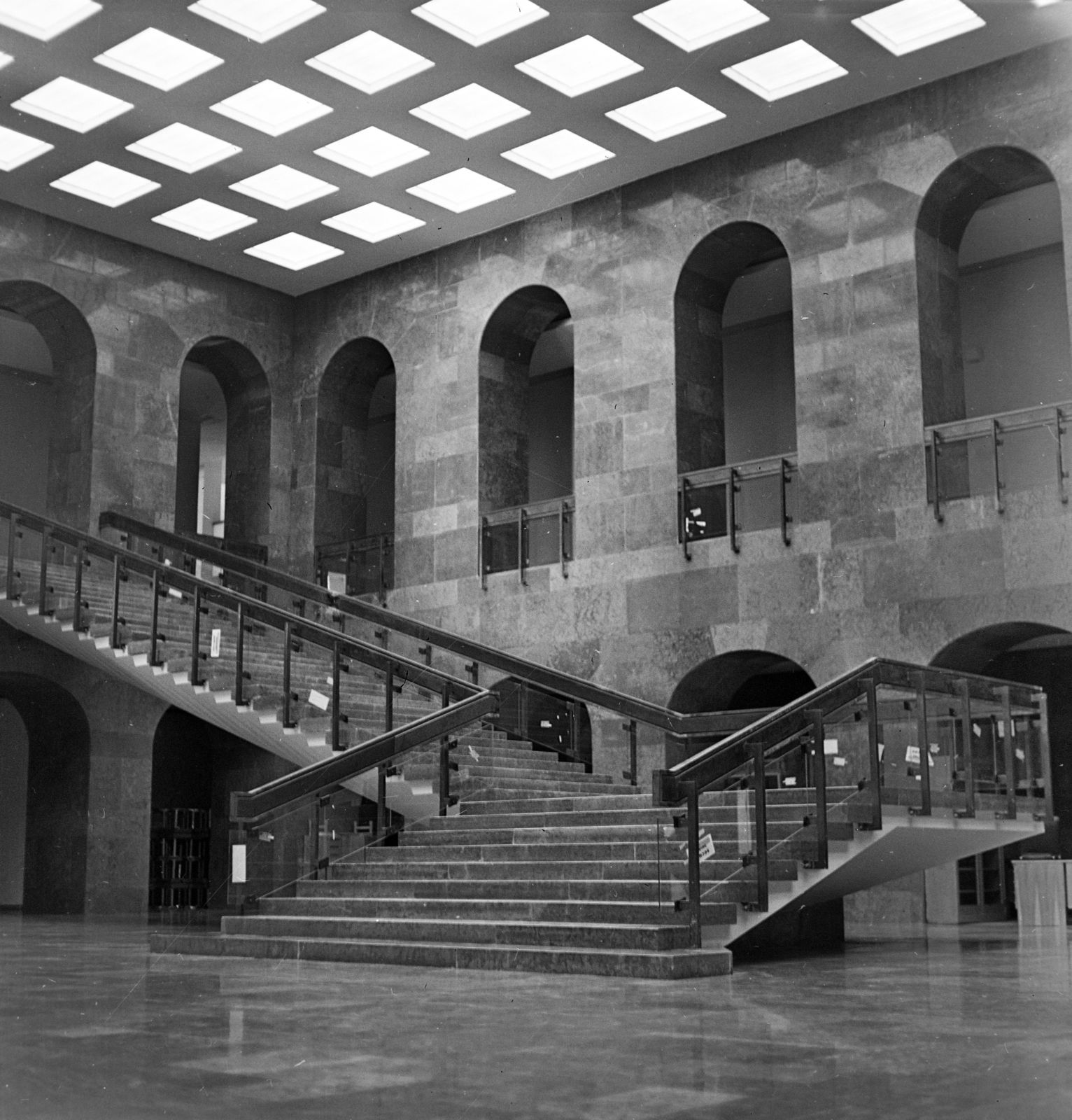
Following the restoration, the Hungarian National Gallery was housed in most of the former Royal Palace. The picture shows the gallery's modern-style staircase in 1975 (Source: Fortepan/No.: 170781)
 The restored eastern facade of the Buda Castle with the new classicising dome (Source: Fortepan/No.: 77663)
The restored eastern facade of the Buda Castle with the new classicising dome (Source: Fortepan/No.: 77663)
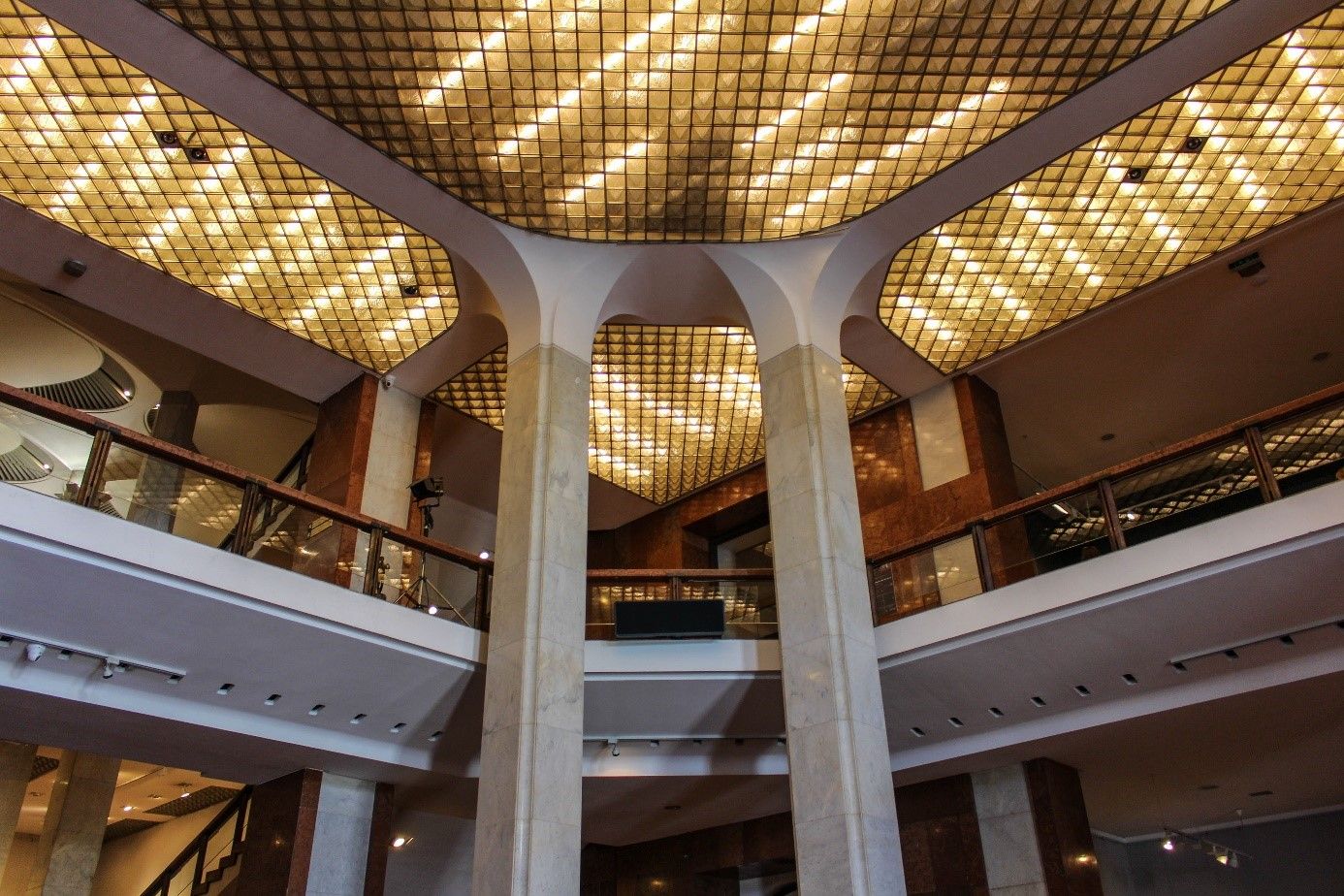
The hall under the dome nowadays (Photo: pestbuda.hu)
The immediate surroundings of the palace, i.e. the Castle Garden, the Riding Hall, the Guard House building, the Royal Riding Hall and the Royal Stable, also suffered significant damage during the siege. The Castle Garden became almost unrecognisable due to the bombings, and the Communist leadership did not want to restore the ornate gardens. Thus, the bastion and gate tower were rebuilt using the foundations of a 16th-century southern rondelle found during excavations in the area.
 Stairs in the gardens of the Royal Palace around 1912 (Source: FSZEK Budapest Collection)
Stairs in the gardens of the Royal Palace around 1912 (Source: FSZEK Budapest Collection)
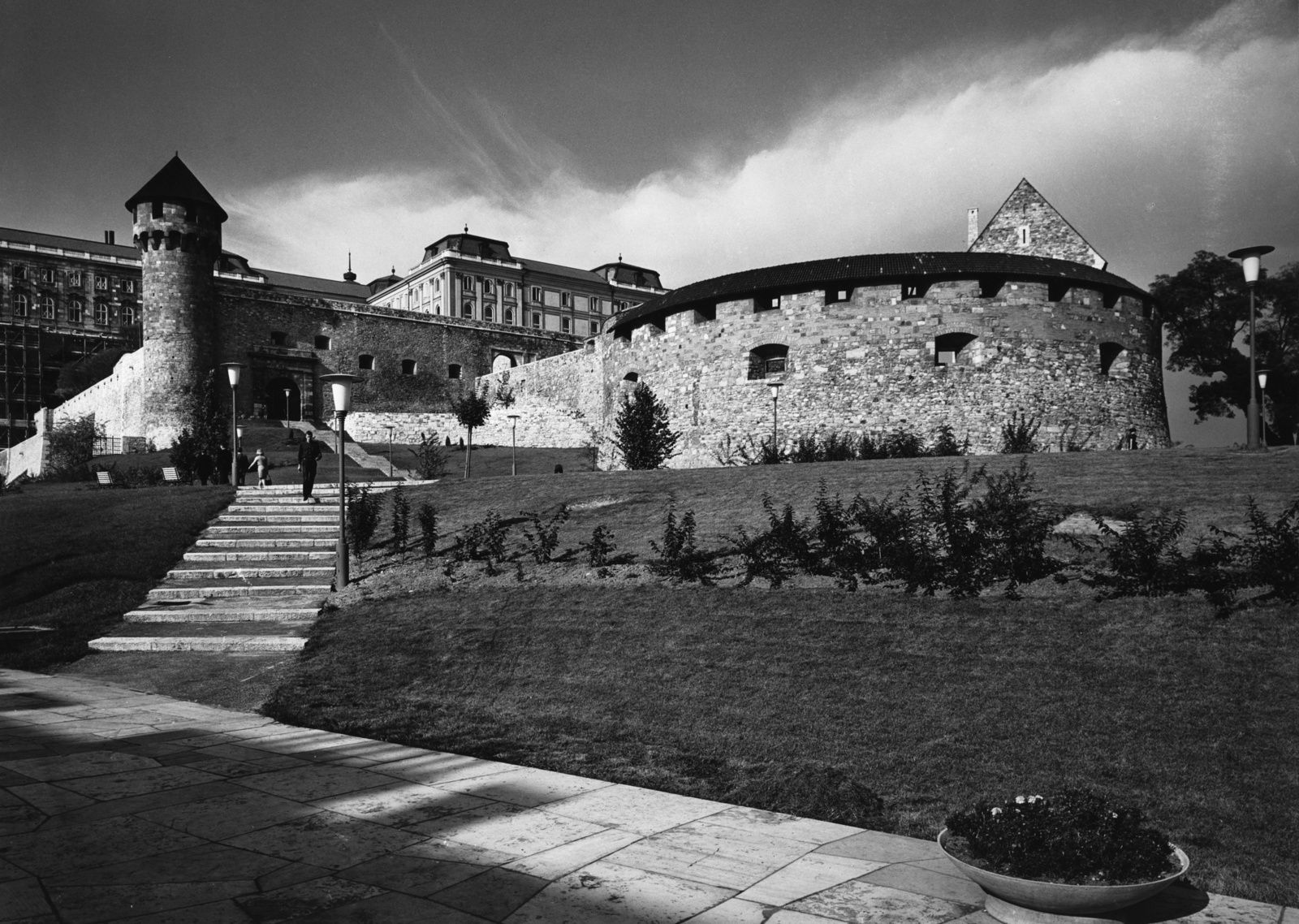
The late medieval fortress system was restored in place of the former ornate staircase. Recorded in 1970 (Source: Fortepan/No.: 77660)
The buildings of the two courtyards on the west side of the Royal Palace, the Csikós and the Hunyadi Courtyards were not so fortunate. The building of the Royal Stable, which can also be considered a western closure of the Hunyadi Courtyard, was demolished after the war for ideological reasons, and ruins were built in its place.
The Guard House building next to the stable was not significantly damaged, but it was demolished much later. The Royal Riding Hall in Csikós Courtyard had a similar fate: the building could have been saved, but it fell to ideological destruction and was quickly demolished after the war.
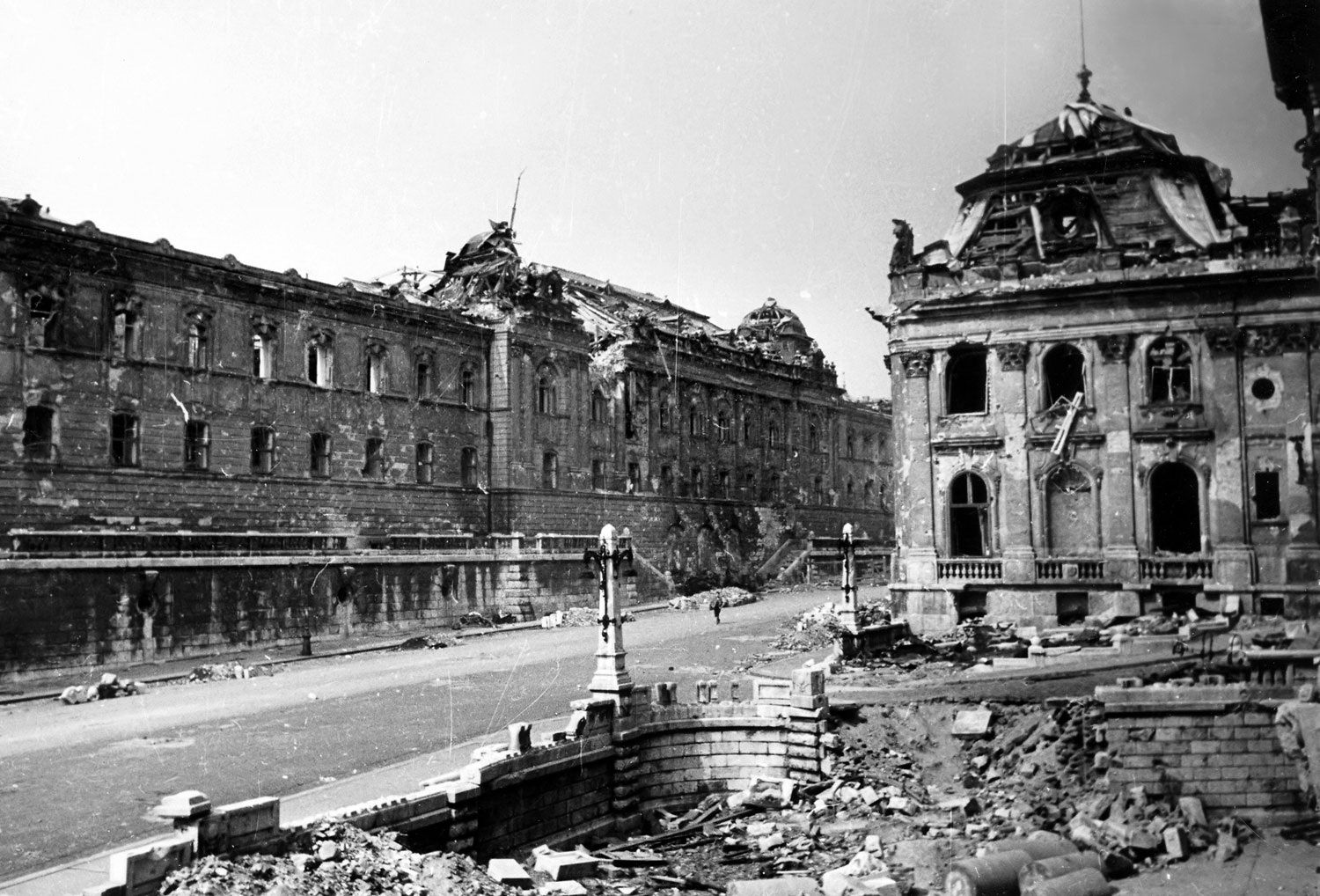 Although it could have been saved (as shown in this 1945 picture), the Royal Stable was demolished (Source: Fortepan/No.: 52049)
Although it could have been saved (as shown in this 1945 picture), the Royal Stable was demolished (Source: Fortepan/No.: 52049)
The damaged Royal Riding Hall and the Guard House building on the left side of the picture in 1945. Outside the castle wall, the Hauszmann foreman's villa, where the plans for the palace and outbuildings were once made (Source: Fortepan/No.: 175125)
The buildings of Szent György Square also fell victim to ideological destruction. The palace in the western part of the square, which was formerly the home of Archduke Joseph of Habsburg-Lorraine and served for educational and housing purposes for some time after the war, was blown up in 1968. Adjacent to the palace stood the former Ministry of Defense building, which suffered repairable damage yet was demolished.
In contrast to the former, the Sándor Palace (once the residence of the Prime Minister) suffered very serious injuries, and only preservation was carried out post-war. It was not until the 1980s that its facade was restored, and then it was reconstructed inside and out in the late 1990s, early 2000s. According to the plans at the time, the building would have regained its former function: the Office of the Prime Minister would have been moved here. However, after the change of government in 2002, the Office of the President of the Republic received the building.
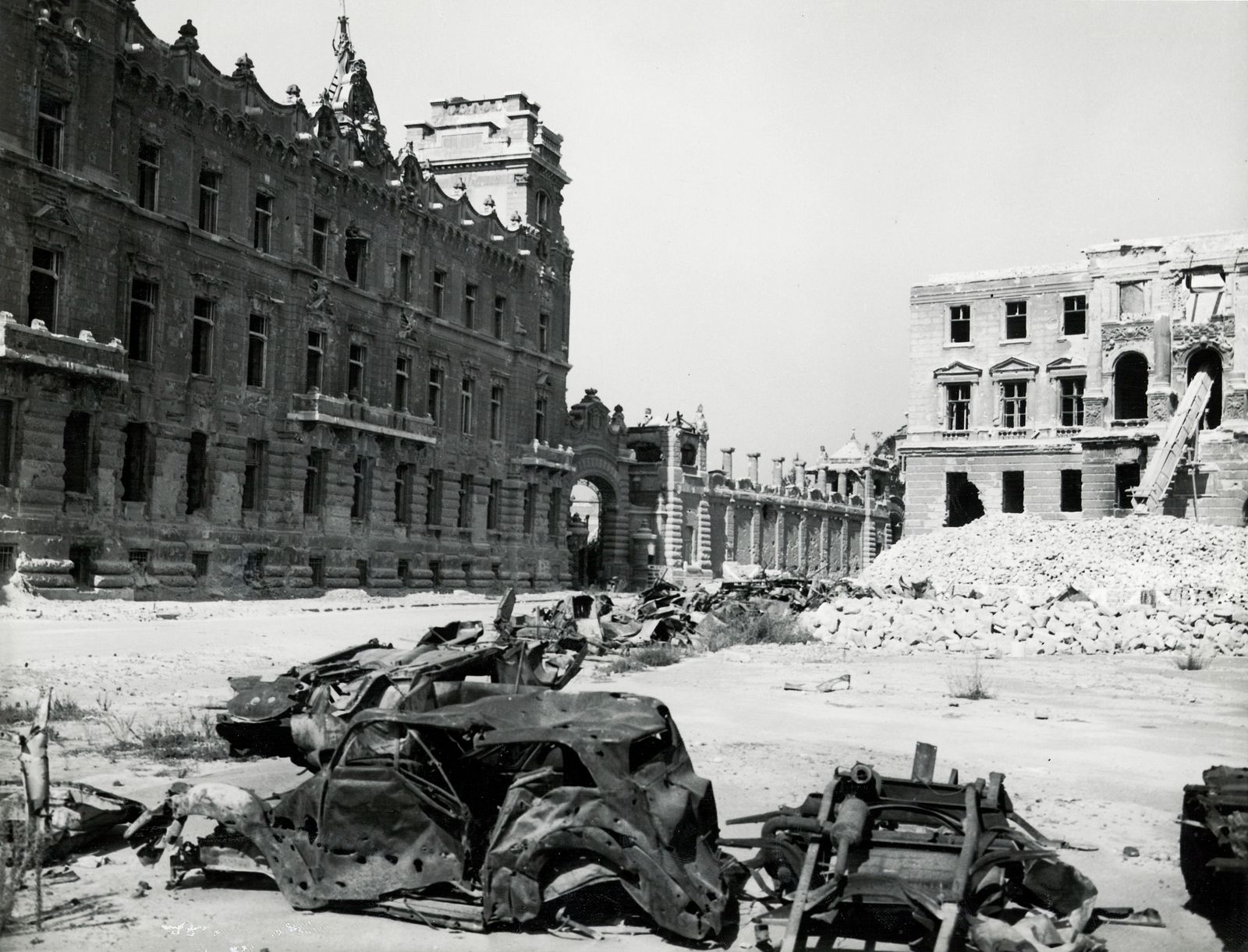 Palace of Archduke Joseph and the building of the Ministry of Defense in 1945 (Source: Fortepan/No.: 105723)
Palace of Archduke Joseph and the building of the Ministry of Defense in 1945 (Source: Fortepan/No.: 105723)
 The ruined Sándor Palace in 1945 (Source: Fortepan/Budapest Archives)
The ruined Sándor Palace in 1945 (Source: Fortepan/Budapest Archives)
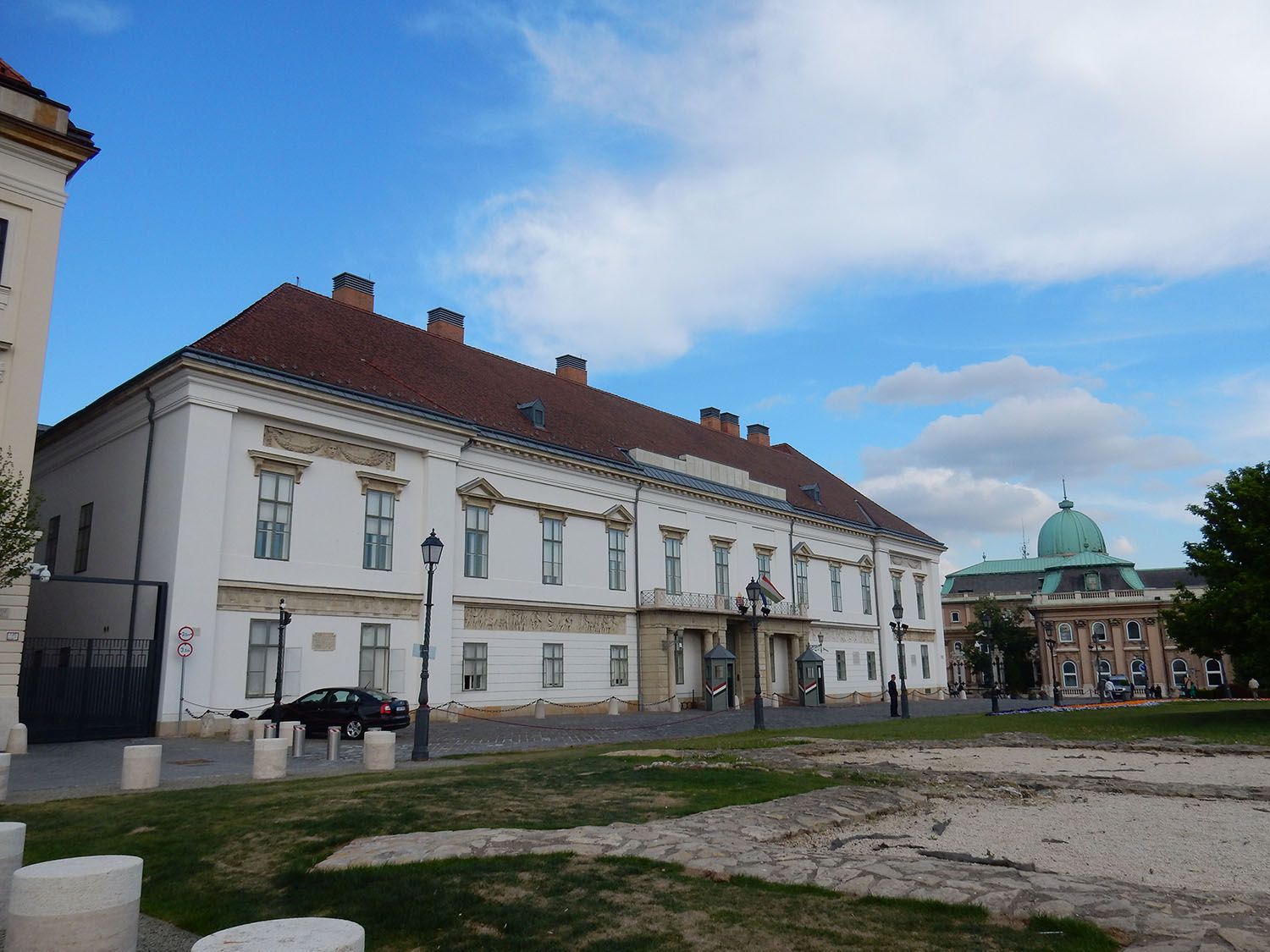
Nowadays, the Sándor Palace shines in its old light again (Source: Péter Bukovszki/pestbuda.hu)
The buildings of the adjacent Dísz Square also suffered from the siege and ideological destruction. Of particular note is the former State Department building on the corner of the square, which was originally built as the headquarters of the Red Cross. The building suffered such severe damage that it was rather demolished with empty plots left in place for decades. In contrast, the building of the neighbouring Headquarters of Hungarian Defense Forces did not suffer any damage that would have justified its subsequent demolition.
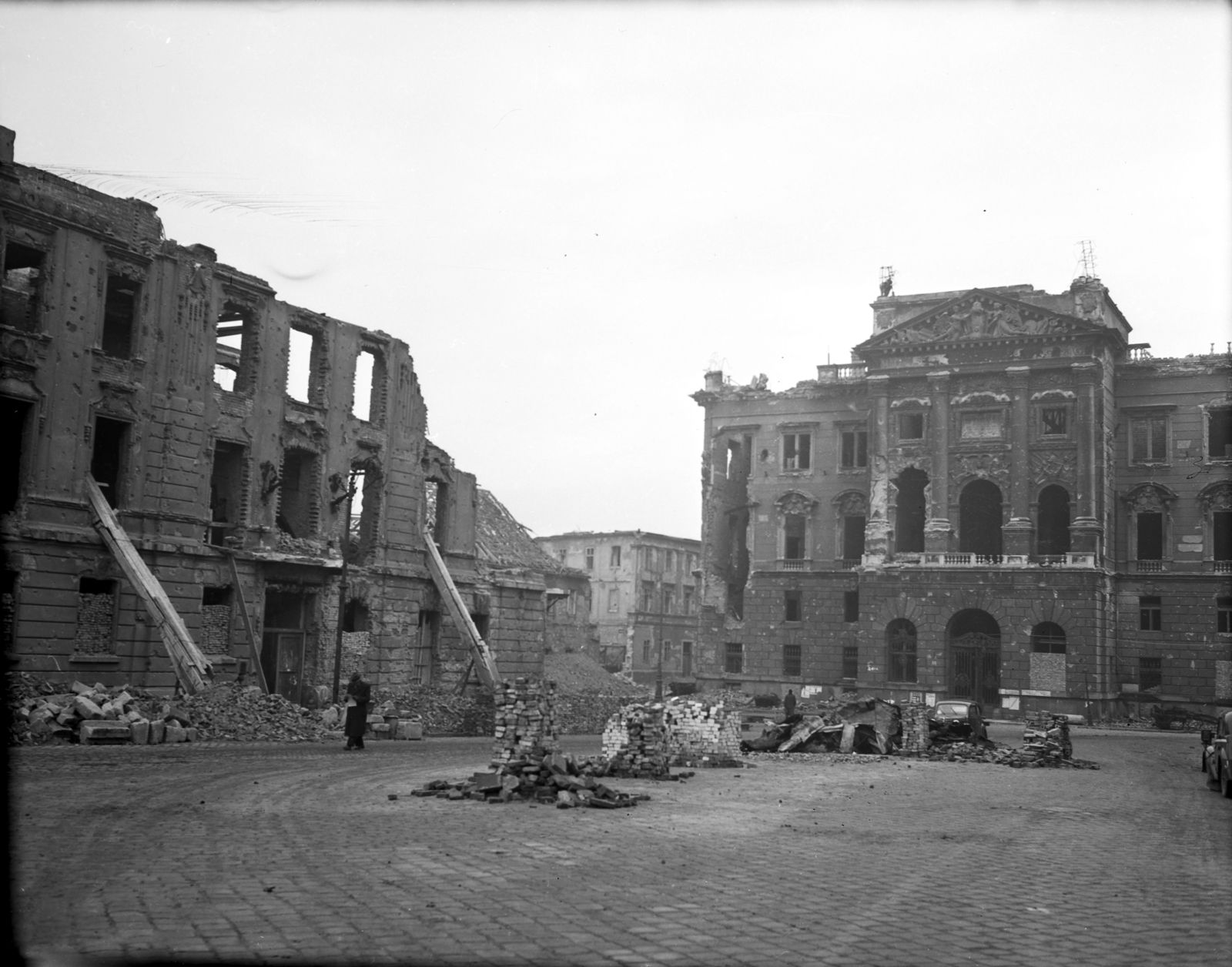 The ruined Ministry of Foreign Affairs (left) and the Headquarters of Hungarian Defense Forces building (right) in 1949 (Source: Fortepan/No.: 105808)
The ruined Ministry of Foreign Affairs (left) and the Headquarters of Hungarian Defense Forces building (right) in 1949 (Source: Fortepan/No.: 105808)

The building of the Headquarters of Hungarian Defense Forces nowadays (Photo: Balázs Both/pestbuda.hu)
The part of the Castle District north of Dísz Square is traditionally called Polgárváros, as the vast majority of it consists of residential houses. But here, too, there were some government buildings and public institutions that also suffered severe damage. Such is the palace of the former Ministry of Finance in Szentháromság Square.
Although the building was in a restorable condition, after 1945, it was decided to make a major reconstruction. It was argued that the ornate Neo-Gothic main facade of the building and the two towers were too ostentatious in the neighbourhood of the Mátyás Church. For this reason, the most significant alteration affected the main facade, but it retained its neo-Gothic character. After the renovation, the building housed the dormitory of the Budapest University of Technology.
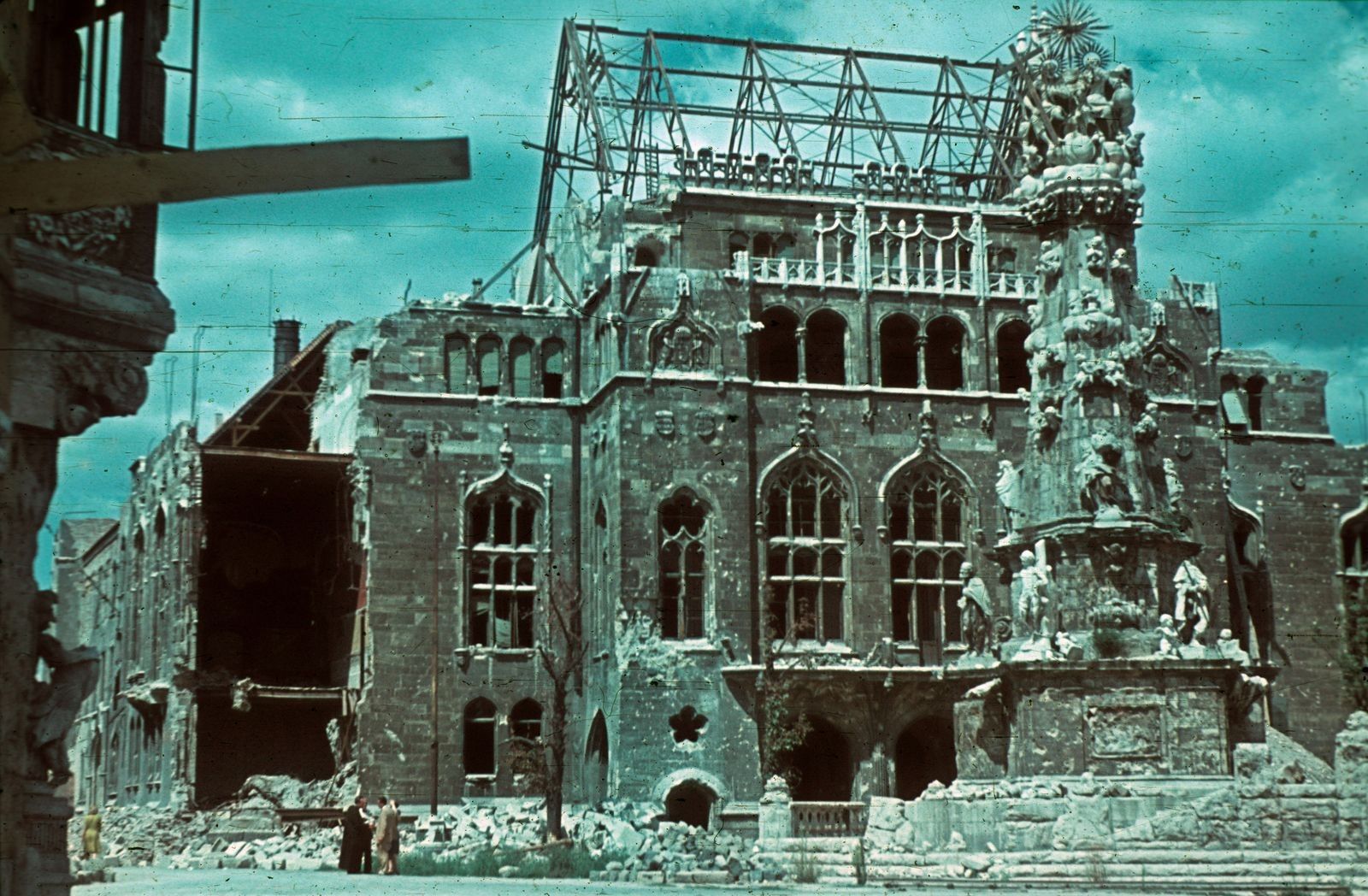 Palace of the Ministry of Finance after the war damage. Demolition of the roof structure and the floor already in progress, 1945 (Source: Fortepan/No.: 96590)
Palace of the Ministry of Finance after the war damage. Demolition of the roof structure and the floor already in progress, 1945 (Source: Fortepan/No.: 96590)

Truncated building of the Ministry of Finance restored in 1954 (Source: Fortepan/No.: 170510)
The former Jesuit College, which stood under today's 1 Hess András Square, also suffered serious injuries in the vicinity of the palace of the Ministry of Finance, where from 1867, the offices of the ministry were located. As the Ministry of Finance was moved to József Nádor Square, the former headquarters of the Hungarian General Credit Bank, the former Jesuit College was not touched for a long time after the war. Finally, in the 1970s, the Hilton Hotel was built here, retaining the Baroque facade facing Hess András Square.

The Mátyás Church also suffered severe damage, but was repaired very soon (Source: Fortepan/No.: 30893)
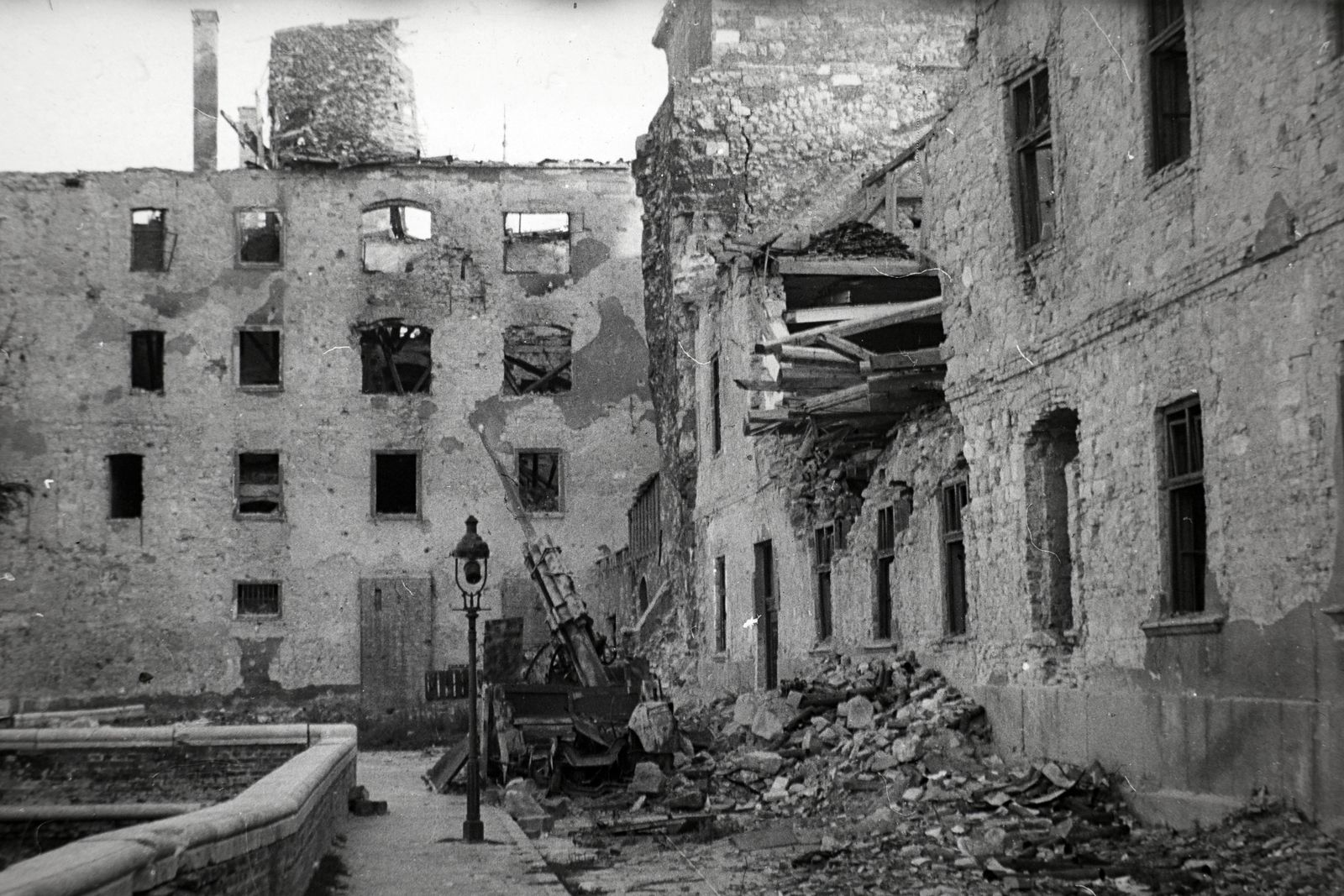
Ruins of the former Jesuit Academy in 1945 (Source: Fortepan/No.: 93909)
At the northern end of the Castle District, on the Bécsi Gate Square, stands the representative palace of the National Archives of Hungary, which received heavy shots in the neighbourhood of the Bécsi Gate (where, as Pestbuda mentioned in a previous article, defenders tried to break out). The iconic and cityscape-defining tower of the Archives, which was blown up back in 1945, was the most damaged.

The tower of the National Archives was severely damaged in 1945. It was blown up in the same year (Source: FSZEK Budapest Collection)
The churches in Buda Castle among the damaged buildings can also be mentioned. The Church of Mary Magdalene, the Lutheran Church in Bécsi Gate Square and the Mátyás Church were also seriously damaged in the siege of Budapest, but the Lutheran Church and the Mátyás Church were soon restored to their original form.
However, the Church of St. Mary Magdalene in Kapisztrán Square, also known as the Church of Local Guard, could not be saved: in 1950, allegedly on Rákosi's personal order, the building was demolished. Only the tower was left, on which preservation was done.
 The ruined Church of Mary Magdalene in 1945 (Source: Fortepan/No.: 52080)
The ruined Church of Mary Magdalene in 1945 (Source: Fortepan/No.: 52080)
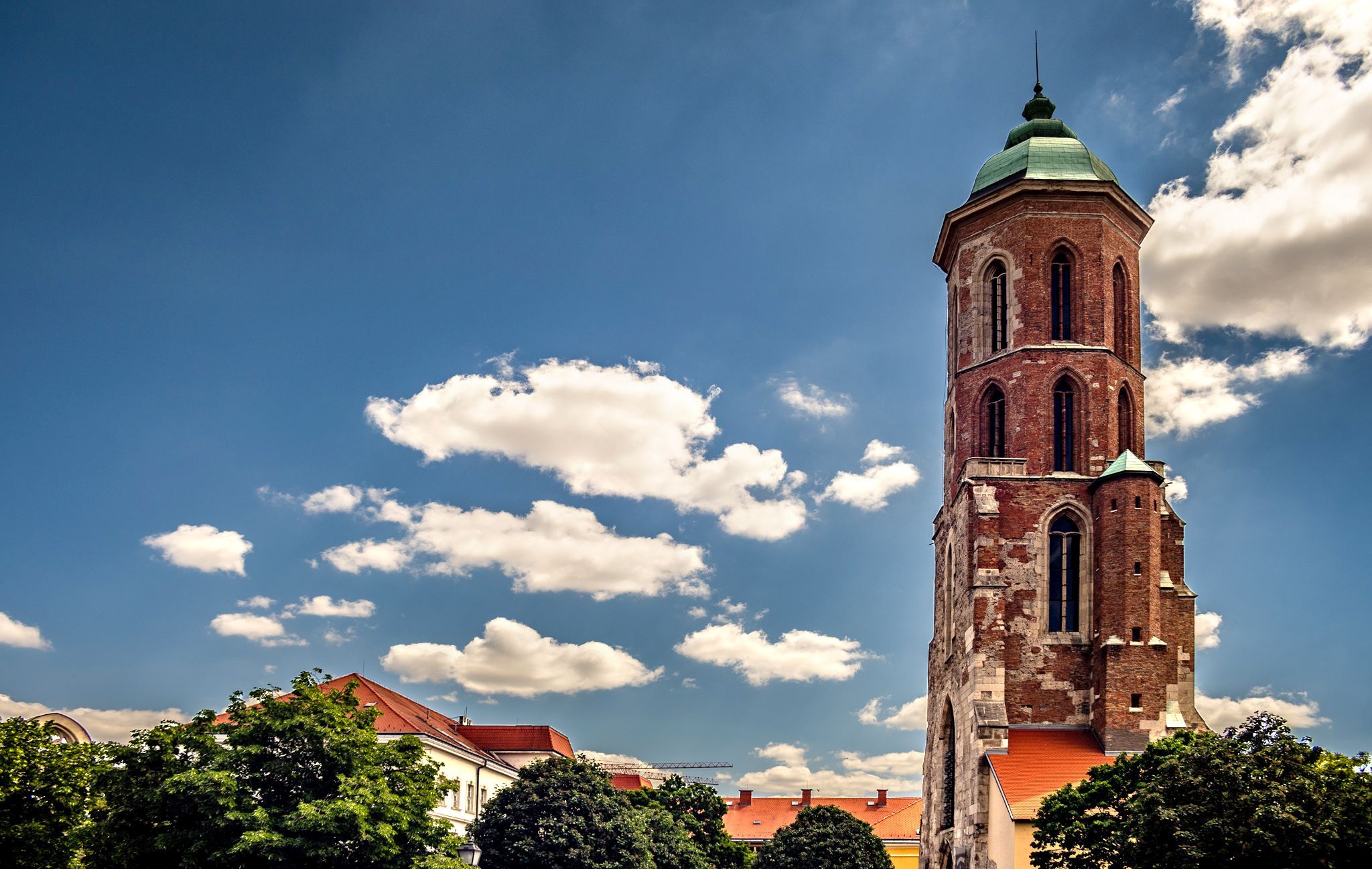
Today the remaining tower of the church is used as a lookout (Photo: Balázs Both/pestbuda.hu)
Of course, many residential houses in the Castle District were also damaged. Most of these were restored mainly with Baroque facades, but there were houses whose architectural decoration was simplified or from which a level was demolished. And there were a few exceptions when they rather demolished the damaged houses and put more modern-looking buildings in their place. A good example of this is the former Burg Hotel on the corner of Szentháromság Square or the residential building at the northern end of Dísz Square.
 The Burg Hotel was closed in 2019 on Szentháromság Square. The building was erected on the site of a war-damaged house (Photo: Balázs Both/pestbuda.hu)
The Burg Hotel was closed in 2019 on Szentháromság Square. The building was erected on the site of a war-damaged house (Photo: Balázs Both/pestbuda.hu)
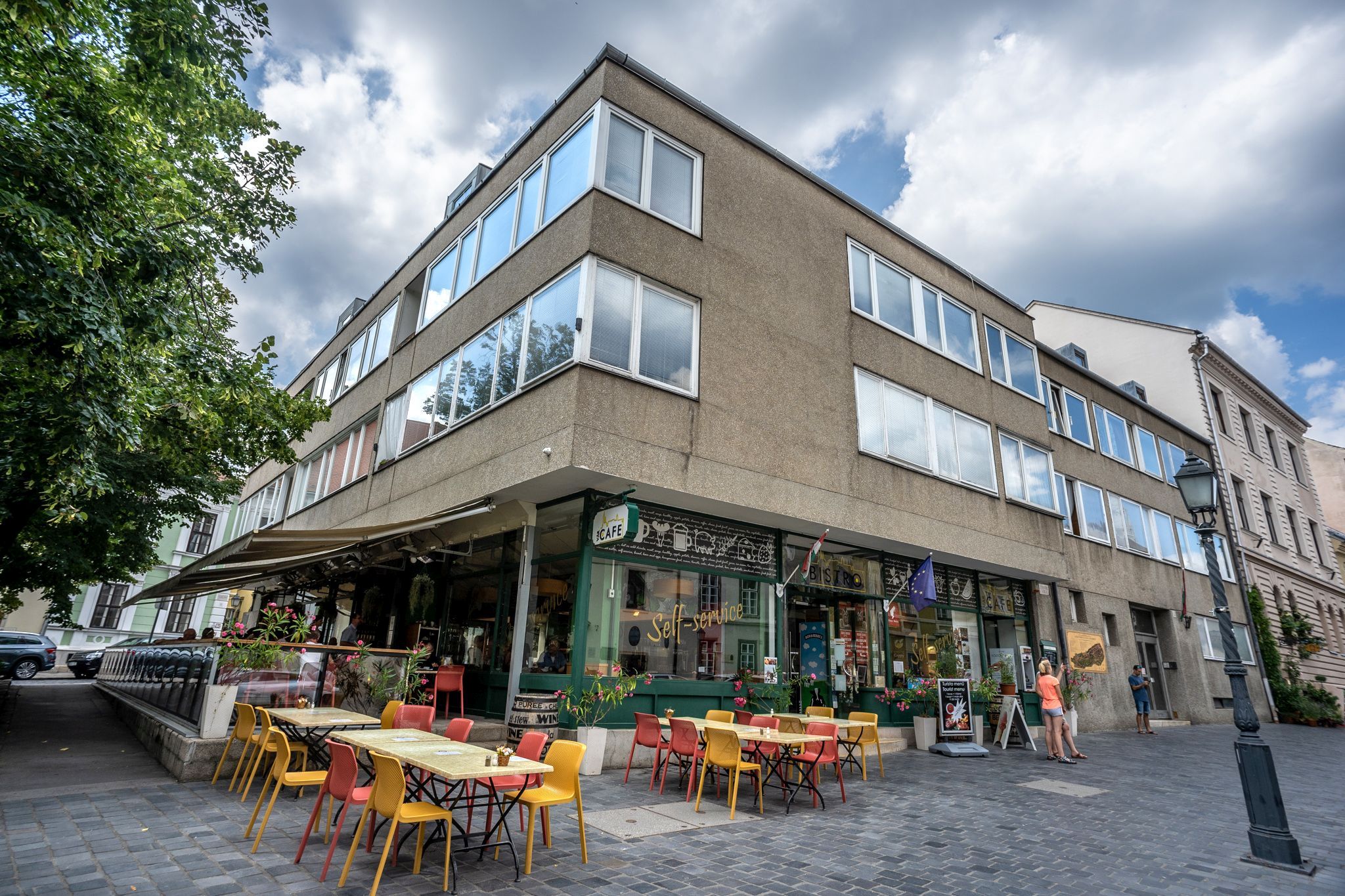
The house at 8 Dísz Square, which was built on the site of a demolished building (Photo: Balázs Both/pestbuda.hu)
Cover photo: Szentháromság Square in Buda Castle in 1945 (Source: Fortepan/No.: 52084)

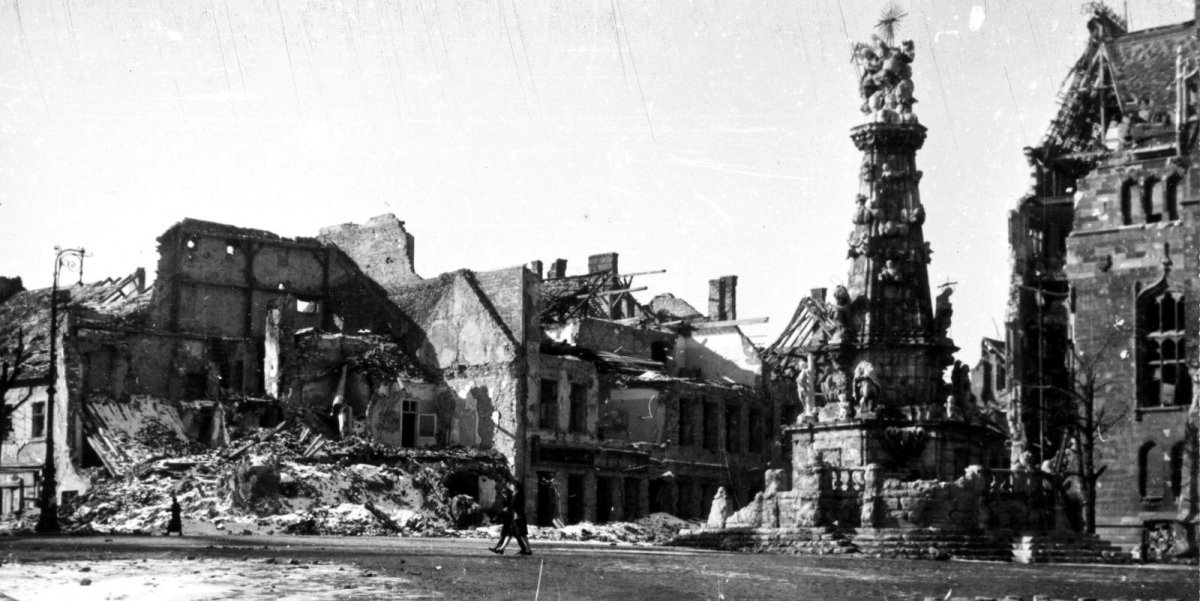


































Hozzászólások
Log in or register to comment!
Login Registration